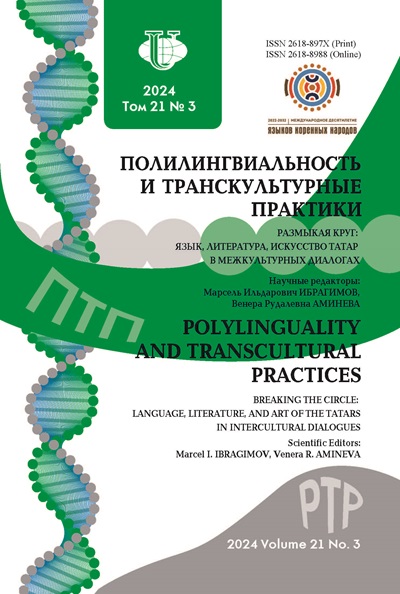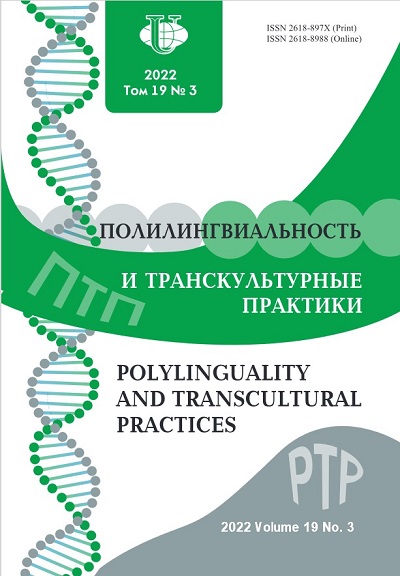The Role of the Intermediary Language in Artistic Translation
- Authors: Akkalieva A.F.1, Amalbekova M.B.2
-
Affiliations:
- Shakarim University
- Eurasian University named after LN Gumilev
- Issue: Vol 19, No 3 (2022)
- Pages: 533-539
- Section: LITERARY SPACE
- URL: https://journals.rudn.ru/polylinguality/article/view/32080
- DOI: https://doi.org/10.22363/2618-897X-2022-19-3-533-539
Cite item
Full Text
Abstract
Indirect translation, as a linguistic and literary phenomenon, is of great interest in terms of linguistic, structural and linguocultural aspects of the languages involved in the translation process. Mediating or indirect translation, despite of being negatively treated both by some scholars and practical translators, remains relevant for the representation of many national literatures, including the Kazakh one. This paper is aimed at conducting a comprehensive and comparative analysis of the translation of a literary piece of fiction to assess the degree of influence of the mediating language on the adequacy and pragmatic equivalence of translation. As an empirical material the authors considered Russian and English variants of translation of the novel by well-known Kazakh writer S. Yelubay Aq Boz Yui . The analysis carried out as part of the study allowed us to come to the conclusion that the Russian translation, which is distinguished by a high degree of skill, recreates the national-historical specificity of the work. This is achieved due to the translator’s knowledge of extralinguistic information. The translation into Russian is dominated by categorical-morphological and pragmatic transformations. The English translation is characterized by lexical transformations. It was also possible to identify inconsistencies caused by structural-stylistic and linguo-culturological differences in the triad of languages under consideration.
About the authors
Aizhan F. Akkalieva
Shakarim University
Author for correspondence.
Email: akkalieva.aizhan@mail.ru
ORCID iD: 0000-0001-6466-9967
Doctor PhD, Senior Lecturer, Department of Foreign Languages
163, Shugaev st., Semey, 070000, KazakhstanMaral B. Amalbekova
Eurasian University named after LN Gumilev
Email: maraluspen@mail.ru
Doctor of Philology, Professor of the Department of Theory and Practice of Translation 2, Satbaev st., Astana, 010000, Kazakhstan
References
- Chukovskii, K. 1968. Vysokoe iskusstvo. Moscow: Sovetskii pisatel’, 1968. Print. (In Russ.)
- Witt, S. 2017. “Institutionalized intermediates: Conceptualizing Soviet practices of indirect translation”. Translation Studies 10(2): 166—182. Print.
- Mashakova, A.K. 2016. “Retseptsiya kazakhskoi literatury i sravnitel’noe literaturovedenie”. International scientific review 10(20): 45—47. Print. (In Russ.)
- Bazarbaeva, A. 2013. “Aktual’nye problemy russko-kazakhskogo perevoda v Kazakhstane”. Vestnik KGU im. Sh. Valikhanova 1-2: 28—33. Print. (In Russ.)
- Elubai, S. 2005. Aқ boz үi: roman-trilogiya. Almaty: Zhazushy. Print. (In Kaz.)
- Elubaev, S. 2005. Odinokaya yurta: roman-trilogiya. Almaty. Print. (In Russ.)
- Yelubay, S. 2016. Lonely Yurt. Brooklyn; NY.: Metropolitan classics Press. Print.
- Keңesbaev, І. 2007. Қazaқ tіlіnің frazeologiyalyқ sөzdіgі [Frazeologicheskii slovar’ kazakhskogo yazyka]. Almaty. Print. (In Kaz.)
- Kazakhsko-russkii onlain slovar’. Web. www.sozdik.kz.
- Қaliev, B. 2014. Қazaқ tіlіnің tүsіndіrme sөzdіgі [Tolkovyi slovar’ kazakhskogo yazyka] Almaty: MTDI publ. Print. (In Kaz.)
- Slovar’ russkogo yazyka: in 4 vol. 1982. Moscow: Russkii yazyk publ. Print. (In Russ.)
- Collins English dictionary. Web. www.colinsdictionary.com















